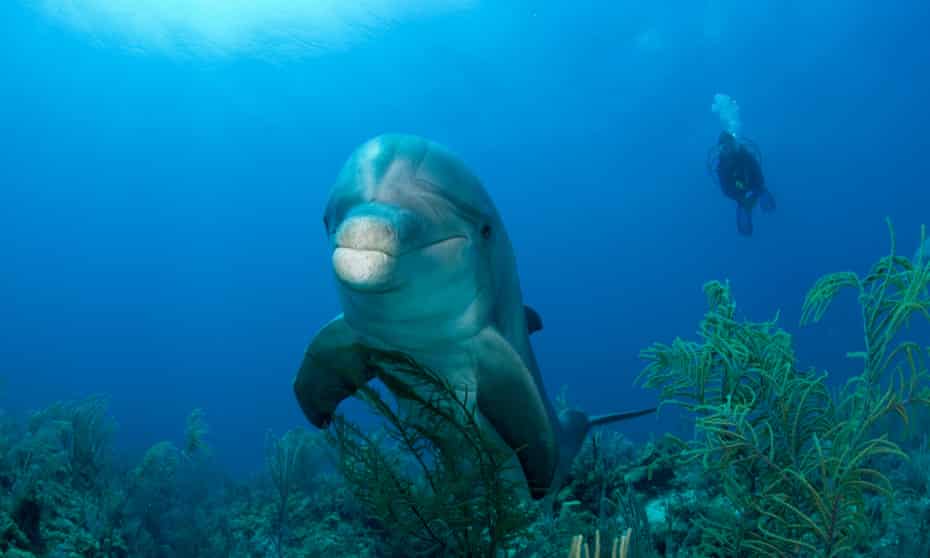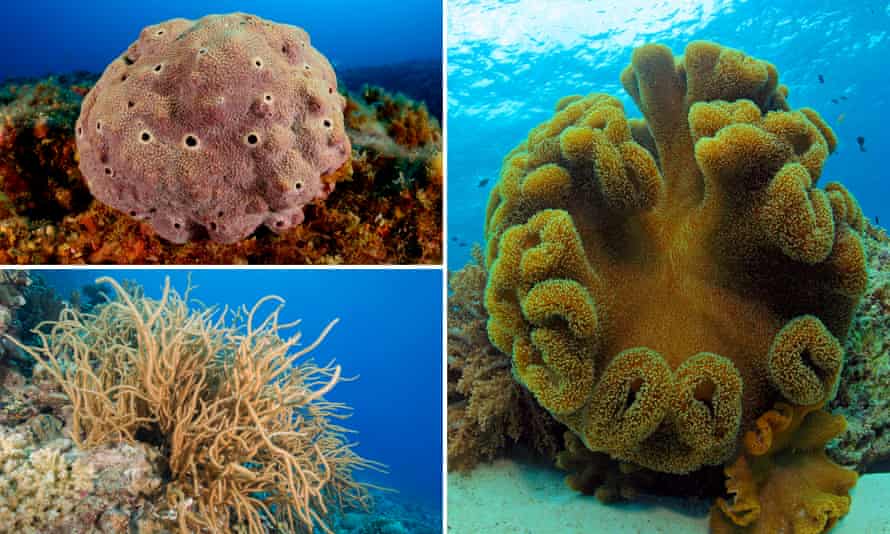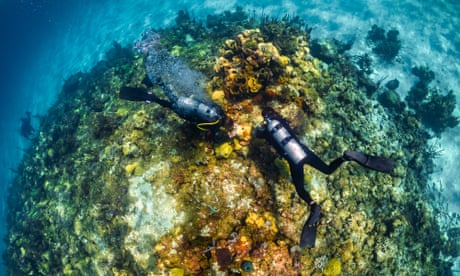
A bottlenose dolphin rubbing its belly on coral. The animals are prone to skin conditions, such as yeast, bacterial and viral pox infections, which seem to be exacerbated by climate change.
Photograph: Cultura Creative RF/Alamy
New research suggests the cetaceans may be self-medicating for their skin ailments, adding to evidence of the medicinal properties of some corals and sponges
Seascape: the state of our oceans is supported by

New research suggests the cetaceans may be self-medicating for their skin ailments, adding to evidence of the medicinal properties of some corals and sponges
Seascape: the state of our oceans is supported by

Thu 19 May 2022
Who doesn’t like a bath scrub? Dolphins definitely do: they are known for being clever, playful, tactile animals, and they like to rub against rough surfaces, nap in coral beds and soak on sponges like guests at an underwater spa.
However, dolphins may be getting more from their bath scrubs than just relaxation and leisure. A study published today suggests that bottlenose dolphins may be self-medicating their skin ailments with the help of corals, adding to growing research on their previously unexplored medicinal properties.
“It’s very intensive,” said Angela Ziltener, one of the study’s lead authors, of the behaviour of the dolphins with particular corals. “They don’t just go through [the coral] – they go up, they come back down again and they rub their belly, their ventral area and the back.”
Who doesn’t like a bath scrub? Dolphins definitely do: they are known for being clever, playful, tactile animals, and they like to rub against rough surfaces, nap in coral beds and soak on sponges like guests at an underwater spa.
However, dolphins may be getting more from their bath scrubs than just relaxation and leisure. A study published today suggests that bottlenose dolphins may be self-medicating their skin ailments with the help of corals, adding to growing research on their previously unexplored medicinal properties.
“It’s very intensive,” said Angela Ziltener, one of the study’s lead authors, of the behaviour of the dolphins with particular corals. “They don’t just go through [the coral] – they go up, they come back down again and they rub their belly, their ventral area and the back.”

Dolphins in the Red Sea cleaning their skin in seagrass. The researchers found dolphins were meticulous in choosing which parts of their body to rub.
Photograph: Natalia Pryanishnikova/Alamy
Dolphins have thick, smooth and resilient skin, but can be prone to skin conditions such as yeast and bacterial infections, scars or tattoo-like lesions caused by viral pox infections. These ailments seem to be exacerbated by global heating.
Ziltener, a wildlife biologist at the University of Zurich, Switzerland, and her team have been surveying a community of 360 Indo-Pacific bottlenose dolphins (Tursiops aduncus) in the northern Red Sea since 2009. They observed that the dolphins often queued up nose-to-tail to rub themselves against corals as soon as they woke up and right before they went to sleep, as if they were showering for the day. As well as a mechanical rub, the dolphins also caused the corals to release a polyp mucus.
The team also noticed that the dolphins returned to the same coral species, and appeared to be meticulous in choosing which parts of their body to rub. They ran lab tests on 48 samples of corals, sponges and coral mucus “chosen” by the dolphins, including the gorgonian coral Rumphella aggregata, the leather coral Sarcophyton sp. and the sponge Ircinia sp.

Dolphins have thick, smooth and resilient skin, but can be prone to skin conditions such as yeast and bacterial infections, scars or tattoo-like lesions caused by viral pox infections. These ailments seem to be exacerbated by global heating.
Ziltener, a wildlife biologist at the University of Zurich, Switzerland, and her team have been surveying a community of 360 Indo-Pacific bottlenose dolphins (Tursiops aduncus) in the northern Red Sea since 2009. They observed that the dolphins often queued up nose-to-tail to rub themselves against corals as soon as they woke up and right before they went to sleep, as if they were showering for the day. As well as a mechanical rub, the dolphins also caused the corals to release a polyp mucus.
The team also noticed that the dolphins returned to the same coral species, and appeared to be meticulous in choosing which parts of their body to rub. They ran lab tests on 48 samples of corals, sponges and coral mucus “chosen” by the dolphins, including the gorgonian coral Rumphella aggregata, the leather coral Sarcophyton sp. and the sponge Ircinia sp.

A bottlenose dolphin scratches itself on bushy black coral (Rumphella antipathes) in the Red Sea. Photograph: imageBroker/Alamy
The results, published in the journal iScience, revealed at least 17 different bioactive metabolites with antibacterial, antioxidative and oestrogen-like hormonal properties, all of which could be useful in skin treatments.
The compounds are not commonly used in antibiotics for humans or animals, but an expanding body of research shows that some corals and sponges have medicinal properties, including antimicrobial.
“Such metabolites are helpful if you have an infection,” said Gertrud Morlock, an analytical chemist at Justus Liebig University Giessen in Germany, and a lead author of the study. “If the dolphins have a skin infection, these compounds could have something like a healing property.
“If you think about it, they have no other options. If they have a problem with the skin, what can they do?”
The results, published in the journal iScience, revealed at least 17 different bioactive metabolites with antibacterial, antioxidative and oestrogen-like hormonal properties, all of which could be useful in skin treatments.
The compounds are not commonly used in antibiotics for humans or animals, but an expanding body of research shows that some corals and sponges have medicinal properties, including antimicrobial.
“Such metabolites are helpful if you have an infection,” said Gertrud Morlock, an analytical chemist at Justus Liebig University Giessen in Germany, and a lead author of the study. “If the dolphins have a skin infection, these compounds could have something like a healing property.
“If you think about it, they have no other options. If they have a problem with the skin, what can they do?”

The researchers tested 48 corals, sponges and coral mucus used by dolphins, including (from top left) the sponge Ircinia sp., the leather coral Sarcophyton sp., and the gorgonian whip coral Rumphella aggregata.
Photograph: Alamy
The authors note that further research is needed to show which coral’s medicinal properties the dolphins need to treat given ailments, and whether these properties have a measurable, positive impact on the cetaceans’ health.
Learning more about the dolphin’s social network and demographic could help with this. Tracking individual dolphins that display the behaviour, and seeing if they have fewer skin diseases or decreased mortality compared with the rest of the group, would make this argument stronger, according to Sarah Powell, a former marine biologist who studies how dolphins transmit their skin diseases but was not involved in the study.
Past research has shown that dolphins like to use coral sponges as foraging tools. “I do not find it to be such a reach that dolphins would utilise corals and other plants in their environment for other purposes,” said Powell.

Highly contagious marine epidemic rips through Caribbean’s coral reefs
Stephanie Venn-Watson, a marine biologist who studies health and longevity in dolphins and was also not involved in the research, said: “Since dolphins are inherently playful and tactile animals who love to rub, it is difficult to be sure that the dolphins are using the corals for medicinal purposes.”
A next step in proving the link would be to show that corals ignored by dolphins lack the same medicinal properties, she said. “This is a nice science-driven itch to be scratched.”
The authors note that further research is needed to show which coral’s medicinal properties the dolphins need to treat given ailments, and whether these properties have a measurable, positive impact on the cetaceans’ health.
Learning more about the dolphin’s social network and demographic could help with this. Tracking individual dolphins that display the behaviour, and seeing if they have fewer skin diseases or decreased mortality compared with the rest of the group, would make this argument stronger, according to Sarah Powell, a former marine biologist who studies how dolphins transmit their skin diseases but was not involved in the study.
Past research has shown that dolphins like to use coral sponges as foraging tools. “I do not find it to be such a reach that dolphins would utilise corals and other plants in their environment for other purposes,” said Powell.

Highly contagious marine epidemic rips through Caribbean’s coral reefs
Stephanie Venn-Watson, a marine biologist who studies health and longevity in dolphins and was also not involved in the research, said: “Since dolphins are inherently playful and tactile animals who love to rub, it is difficult to be sure that the dolphins are using the corals for medicinal purposes.”
A next step in proving the link would be to show that corals ignored by dolphins lack the same medicinal properties, she said. “This is a nice science-driven itch to be scratched.”
No comments:
Post a Comment